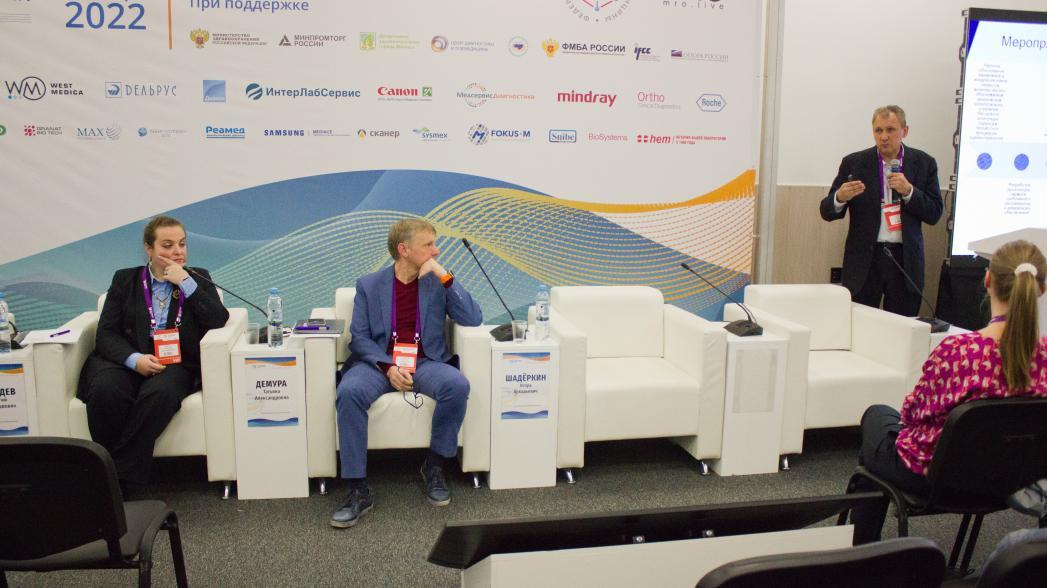News
Digital transformation of the pathology service: a bridge between the clinician and the pathologist
How to reduce the disunity of clinicians and pathologists, relieve specialists from routine work, and improve the quality of medical care? The participants of the session “Digital transformation of the pathoanatomical service: a bridge between a clinician and a pathologist”, which took place within the framework of the VIII Russian Congress of Laboratory Medicine (RCLM) and the Russian Diagnostic Summit (RDS), were looking for answers to these questions. The forums took place on September 6-8 in Moscow.
The Institute of Digital Medicine of Sechenov University has created an original approach to improving the efficiency and quality of training of specialists, a new direction has been formed - the didactics of medical informatics, said the head of the Department of Information and Internet Technologies, Director of the Institute of Digital Medicine, Doctor of Technical Sciences. Georgy Stanislavovich Lebedev.
In order to achieve the greatest effect in the development of services and training of specialists, you need to adhere to several principles. This is a multidisciplinary approach to the formation of the teaching staff, a "cross" competence-oriented approach: the joint work of students - doctors and students-engineers, a practice-oriented approach: the participation of students in the implementation of innovative implementations and research work.
G.S. Lebedev emphasized:
Practical experience in medical organizations at the place of implementation of digital services, participation in approbation and testing of solutions and technologies is important. Preference should be given to interactive teaching technologies, to develop systemic thinking and analytical skills of students.
The Institute of Digital Medicine of Sechenov University is ready to serve as the basis for the creation of the Federal Innovation and Education Center (FIOC), which will be engaged in the scientific justification and development of digital medical services, approbation and testing of digital medical services, maintaining the relevant federal register, facilitating their implementation and launch on international markets, development of a unified educational standard "medical informatics", training of teachers of other medical universities and IT specialists. The corresponding proposal to the university is recommended to be sent to the Ministry of Health of Russia.
The significant workload on pathologists, the lack of equipment for pathological staff and the urgent need to change the work of specialists and introduce new technologies that will optimize and facilitate work with pathoanatomical material, was also discussed in her report by Doctor of Medical Sciences, Professor, Academician of the Russian Academy of Natural Sciences , Director of the Institute of Clinical Morphology and Digital Pathology, First Moscow State Medical University named after I.M. Sechenov of the Ministry of Health of Russia (Sechenov University) Tatyana Aleksandrovna Demura.
She touched upon the advantages of digital pathology in comparison with the traditional one: not only in diagnostics and treatment, but also in science and education. T.A. Demura touched upon the prospects for the use of artificial intelligence (AI) in pathoanatomical and clinical diagnostics, including predicting the effectiveness of current therapy, treatment outcomes, typing and determining the stage of the disease; identifying signs that indicate a positive response to treatment.
Drew the attention of colleagues Ph.D., urologist, head. Laboratory of e-health of the Institute of Digital Medicine of the Federal State Autonomous Educational Institution of Higher Education First Moscow State Medical University named after I.M. Sechenov of the Ministry of Health of Russia (Sechenov University) Igor Arkadyevich Shaderkin:
Clinicians and pathologists are separated from each other, they very rarely have personal contact and rarely hold consultations, also because they are extremely limited in time and can be located in different buildings. In addition, sometimes they use different terminology.
At the same time, the clinician has a huge responsibility, it is he who is responsible for the final decision on the diagnosis and treatment of the patient.
A survey conducted among Russian doctors showed that the vast majority of clinicians want to have access to the primary data of a diagnostic study (CT scans, MRI images, histological glasses, etc.) and be able to hold a consultation with a diagnostician. The respondents are convinced that the joint work of clinicians and diagnosticians will improve the quality of medical care.
What else gets in the way of working together? A third of the respondents answered that there is a shortage of specialists and competencies.
I. A. Shaderkin introduced the audience to the possibilities for the digital transformation of the pathoanatomical service: from an electronic medical record to artificial intelligence and hardware and software systems, such as the domestic RoboScope.
RoboScope allows you to automatically (without human intervention) scan and digitize histological preparations in the open and widely used DICOM format in Russia and the world. It not only automates many processes associated with pathomorphological studies, but also improves their quality and increases the accuracy of diagnosis. In the future, this will create opportunities for the formation of a date sets, the use of machine learning and artificial intelligence, for training on virtual preparations, the introduction of telementoring, the development of telemedicine and pathomorphology. And access to information from a wide range of doctors will just create the conditions for an interdisciplinary approach in the management of complex patients, which is so lacking in doctors today.
Digital pathomorphology is not only the digitization of glasses, but also the transfer to a digital platform of the entire process, from the moment of diagnosis, surgical manipulation, to the analysis of digital images and the participation of the patient in this process, the speaker emphasized. The individual blocks that should make up a single digital pathology platform already exist, but it takes effort and time to combine this into a single digital platform.


Roboscope Patology LLC
Политика конфиденциальности
Согласие на обработку персональных данных
Moscow

2025




